Flowers have a special way of conveying emotions and sentiments. Across various cultures, flowers have always been a sign of joy and happiness. They brighten up spaces with their lively colors and soothing scents.
In this article, we will talk about flowers that mean happiness. Here is our selection of 11 gorgeous flowers that are perfect for occasions filled with smiles and laughter.
1. Sweet Pea (Lathyrus odoratus)
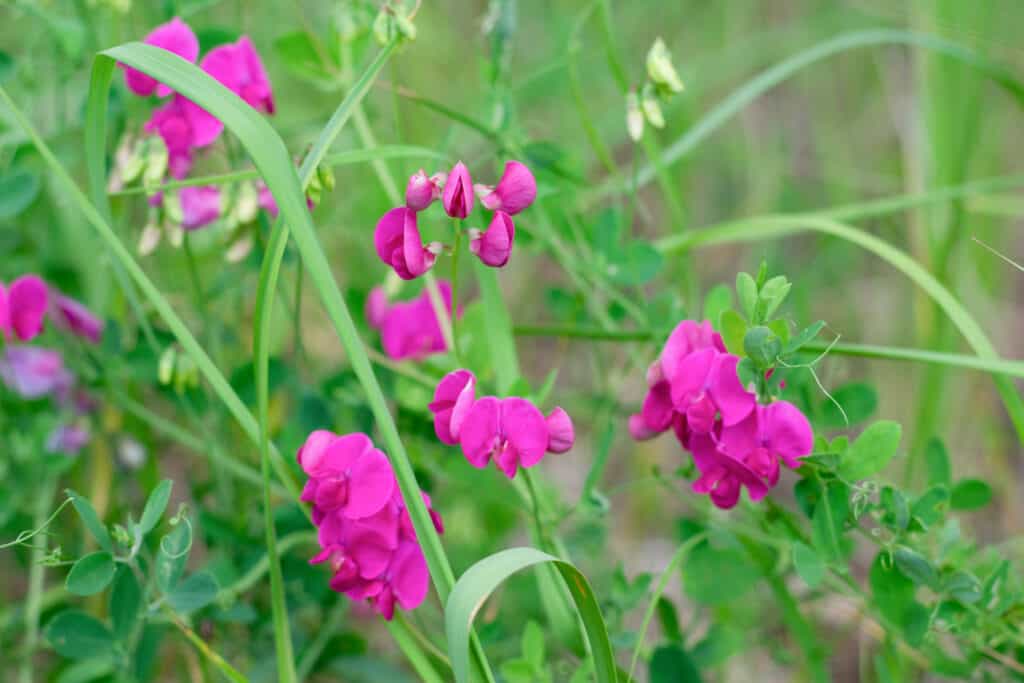
An annual plant, sweet pea boasts incredibly fragrant flowers that come in a wide range of colors.
©iStock.com/Leisan Rakhimova
Sweet pea is an annual that either takes a bushy or climbing form, boasting highly aromatic flowers. The stem, which features wings, is adorned with pairs of medium to dark green leaflets. The “odoratus” in its name hints at its fragrant nature.
The blooms of the sweet pea come in various different colors, showcasing shades like salmon pink, peach, fuchsia, mauve, and periwinkle blue. Despite the vast array of hues available, it’s notable that there are no yellow variants of this flower. Each flower typically measures between 1 and 3 inches in diameter.
The scent of sweet peas is profoundly sweet, true to their name, offering a refreshing aroma when encountered in nature or in lovely bouquets.
The tender and pleasing fragrance of the sweet pea makes it a representation of joy and delight. During the Victorian era, these blossoms were a popular choice to grace dinner events or to be a part of wedding festivities, owing to their delightful scent and association with happiness. After all, smelling these sweet flowers would make anybody immediately happy! Furthermore, sweet peas are often connected to the imagery of a paradise.
2. Daffodil (Narcissus)

There are many meanings that daffodil flowers convey, including happiness, hope, and a fresh start.
©Andrew Fletcher/Shutterstock.com
Daffodil plants sprout a single bright flower on a tall green stem, with leaves sprouting at the bottom of the stem. The size of each bloom differs on the type of daffodil plant. For example, a bloom can be as big as 5 inches, while others are much smaller at less than an inch long. These flowers are one of the first to bloom in spring, which is why people often associate them with Easter.
While many know daffodils for their bright yellow color, they can actually be found in many other colors. You can find them in shades of white, pink, and orange, sometimes mixed with yellow, in both bright or soft colors.
People see daffodils as symbols of a fresh start, hope, and happiness. They pop up every spring, adding a splash of joy to empty gardens with their bright and happy petals. They also represent a love for life and tend to make people happy with their presence. Daffodils are also a popular gift to celebrate ten years of marriage.
3. Stocks (Matthiola)
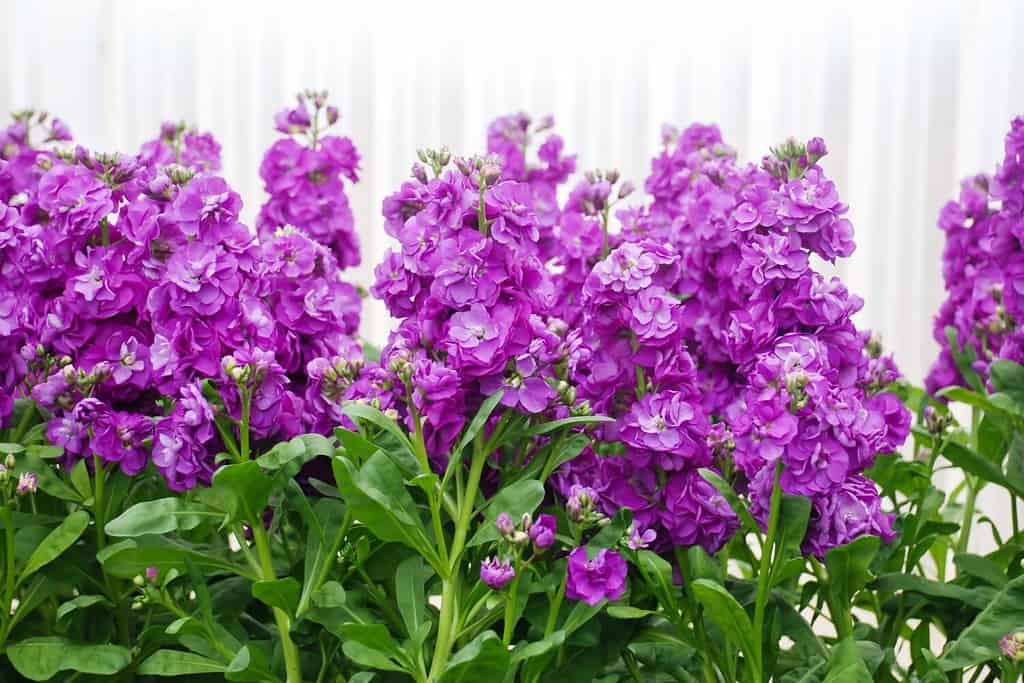
Boasting spikes of flowers, stock flowers often convey meanings of happiness, beauty, and a fulfilling life.
©Yui Yuize/Shutterstock.com
Stock flowers showcase slender, deep green leaves and bloom with spikes of flowers that range in color from lilac to white. While these are their natural colors, many garden versions come in shades like red, yellow, crimson, and deep violet. Some even flaunt double blossoms.
Belonging to the cabbage family, both the flowers and the green seed pods of the stock plant are edible! In fact, stock flowers share the family’s snappy and fresh taste. This makes them a great addition to salads or even as simple garnishes to elevate a dish.
Often referred to as gilly flowers, stock flowers exude a spicy, clove-like aroma. Their prolonged bloom duration and fragrance associate them with enduring beauty, a fulfilling life, and happiness. They are seen as symbols of joy, cheerfulness, and overall good vibes. So, if that’s the type of message you want to convey in a flower, stocks are a beautiful choice. In certain cultures, they even represent good fortune and prosperity!
Given their enduring bloom and vivid colors, they are also celebrated as emblems of happiness across various European countries.
4. Lupine (Lupinus)
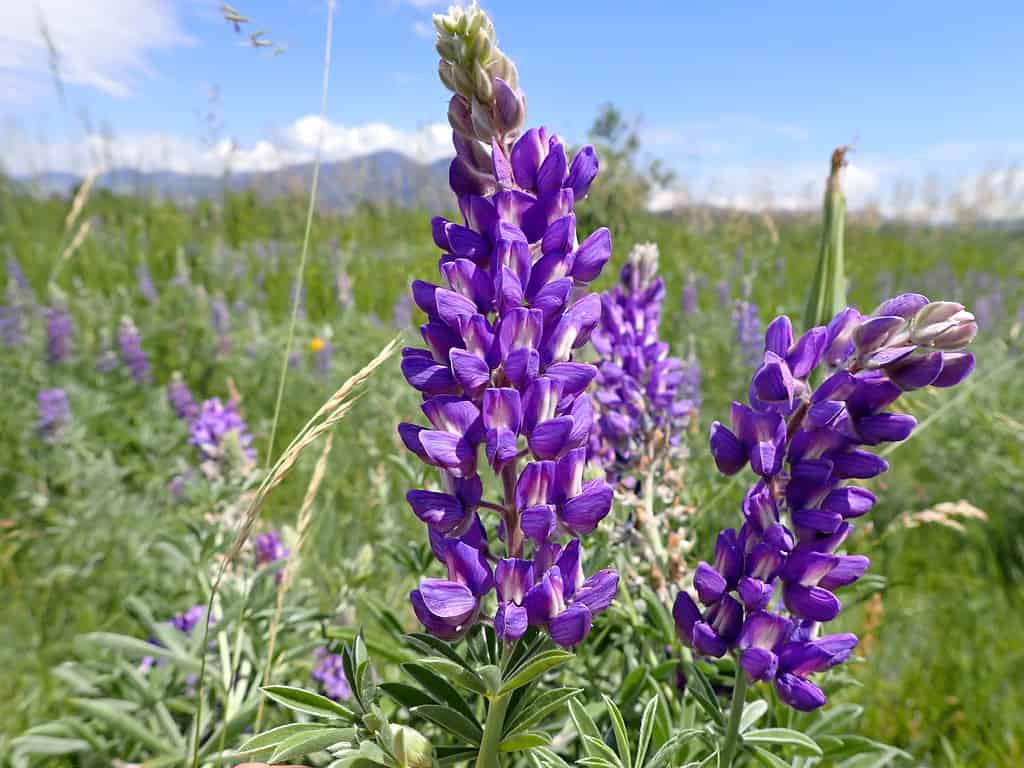
It’s no surprise that the cheerful blooms of lupines convey the meaning of happiness and prosperity.
Lupines feature delicate leaves that have a silver-hued coating due to dense hairs. Their tall stalks, reaching 1-2 feet, proudly bear eye-catching, elongated clusters of pea-like flowers. These flowers arrange themselves in tall, upright clusters, standing majestically on stems surrounded by complex, palm-shaped leaves, which are segmented into 7 to 11 leaflets.
Lupines traditionally display colors of blue, purple, pink, white, or yellow. However, recent cultivations have introduced a number of other colors to this vibrant floral family. These beautiful blooms make their appearance predominantly in the summer months of June and July. They form spectacular displays that can constitute up to half the plant’s total height.
Dating back to ancient times, lupines have always held significant meaning. In historical Chinese culture, they were cherished as flowers of happiness and prosperity. They were believed to ward off negativity and sickness within households. Even in modern times, they are seen as symbols of happiness and the promise of new beginnings, bringing a touch of joy wherever they are found.
5. Wishbone Flower (Torenia fournieri)
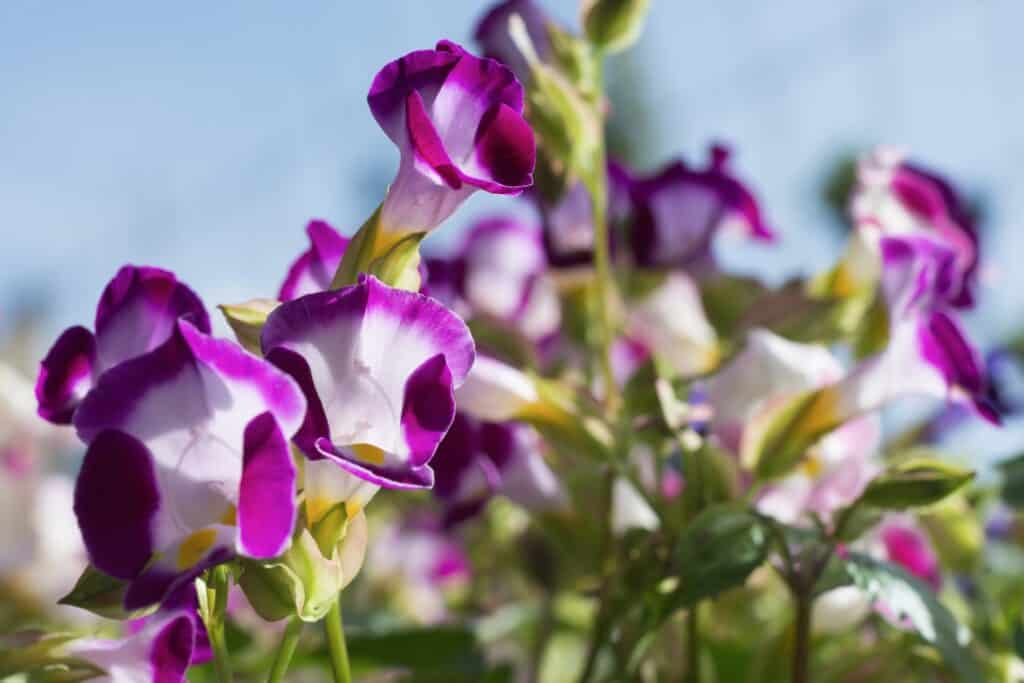
While you may think the wishbone flower is simply a sign of luck, this flower can also mean happiness and new beginnings.
©Isnan Wijarno/Shutterstock.com
The wishbone flower is a seasonal flower that flourishes in shaded or woodland areas during warm, humid conditions. Its physical characteristics include forming a dense, bushy structure about one foot tall with numerous branching stems. Its leaves take on either an oval or a heart-shaped appearance. A unique feature of this flower is its open, snapdragon-like blossoms adorned with distinct markings on their petals.
This flower comes in a delightful variety of colors, encompassing tones of yellow, pink, purple, and white, each one seemingly more magical than the previous. Additionally, they exude a light fragrance reminiscent of clean and fresh green beans.
Given its distinctive visual appeal, the wishbone flower is often linked with elements of happiness and charm. Moreover, this flower carries a reputation for being a sign of luck, as you might be able to guess from its name. Its name, which evokes images of the traditional wishbone, embodies hopes of prosperity, a promising outlook on the future, and the inception of new, positive beginnings.
Due to its association with numerous positive attributes, it’s frequently regarded as a floral that means happiness in its purest form.
6. Dandelion (Taraxacum)

The three stages of a dandelion’s life represent the sun, moon, and stars.
©Wirestock/iStock via Getty Images
In regions with mild weather, dandelions bloom almost throughout the year. Each yellow flower, measuring between 1 and 2 inches in diameter, graces the top of a slender, hollow, and leafless stem that stands anywhere from 2 to 12 inches tall. This bright blossom is actually composed of numerous tiny, yellow, petal-resembling ray flowers. While the majority of dandelions sport yellow blooms, some varieties may have white or pink flowers.
A remarkable aspect of the dandelion is its representation of three heavenly bodies at various stages of its existence – it embodies the sun, moon, and stars. Specifically, the yellow flower embodies the sun, the white puff ball embodies the moon, and the seeds that scatter across the field embody the stars.
The radiant yellow color of the dandelion carries the meaning of happiness and joy, making it an excellent choice for festive occasions. Furthermore, the sunny color of the dandelion serves as a reminder of the vitality and energy of the sun. In essence, this cheerful yellow bloom conveys joy and warmth.
7. Sunflower (Helianthus)
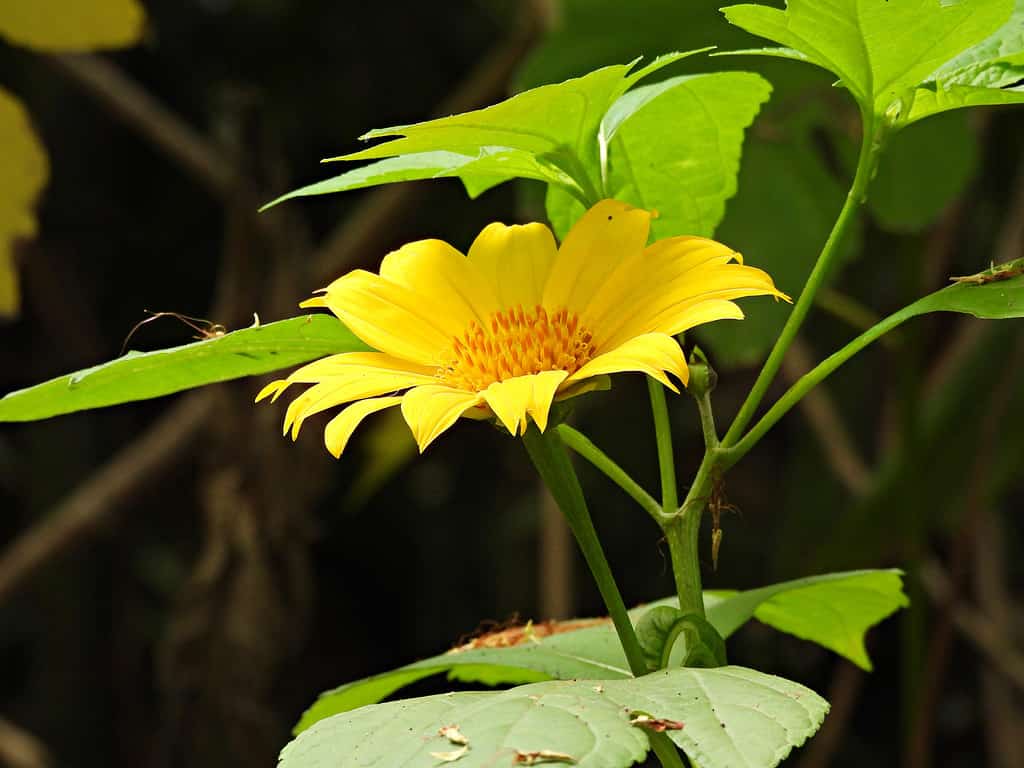
With their bright and cheerful look, sunflowers send a message of hope, happiness, and light.
©passion4nature/iStock via Getty Images
Sunflowers are versatile plants characterized by their large, striking flower heads. They are aptly named for their tendency to rotate their blooms from east to west, following the journey of the sun across the sky. The spectrum of sunflower colors spans from creamy whites to golden yellows and includes shades of orange, red, and even deep mahogany and chocolate brown. While you might encounter pink sunflowers as well, be skeptical of blue sunflower seeds on offer, as true blue sunflowers do not exist naturally.
In reality, what seems like a single blooming entity in a sunflower is a congregation of thousands of tiny individual blossoms. The dark core is an assembly of disk florets, each forming a little tube with five small dark petals. Meanwhile, the structures that we often refer to as “petals” are not petals at all.
Sunflowers serve as a message of hope and happiness, with their bright yellow structures having the ability to bring light and joy into any space. Often chosen as gifts to express affection and a sense of positivity, they are well-received tokens of appreciation. The brilliant colors and cheerful nature of sunflowers are the reasons they carry the meaning of happiness and uplifting spirits with their sun-like demeanor. The sunflower is associated with other meanings as well, such as loyalty, admiration, and strength.
8. Lily (Lilium)

Lilies can come in various different shapes and colors, all with different meanings, including happiness.
©Patrick Enos/Shutterstock.com
The true lilies are upright perennial plants characterized by leaf-adorned stems, layered bulbs, generally slender leaves, and singular or grouped blossoms. Usually, lilies boast flowers with six tepals, presenting themselves in various formations such as trumpet, funnel, or bell shapes, sometimes drooping or featuring backward-curling petals. They stand on rigid, single stems, ranging from 1 to 8 feet in height, adorned with slender to oval-shaped leaves. These blossoms, often endowed with a pleasant fragrance, grace us with a wide array of colors, with blue being the exception.
In the past, the Babylonians connected the symbolism of the lily with the goddess of creation and prosperity. In Roman lore, Venus, the goddess of affection, saw the lily, was jealous of their beauty, and cursed it. And finally, in Japanese culture, the lily is viewed as a symbol of prosperity and happiness. However, with that said, the meaning may differ depending on the color of the lily itself.
Overall, the lily means happiness, serving as a wonderful means to brighten up a person’s day. Whether as a thoughtful present or a centerpiece in a bouquet, this bloom promises to induce smiles, infusing a touch of joy and hope wherever it is placed. This flower also means rebirth and purity.
9. Rose (Rosa)
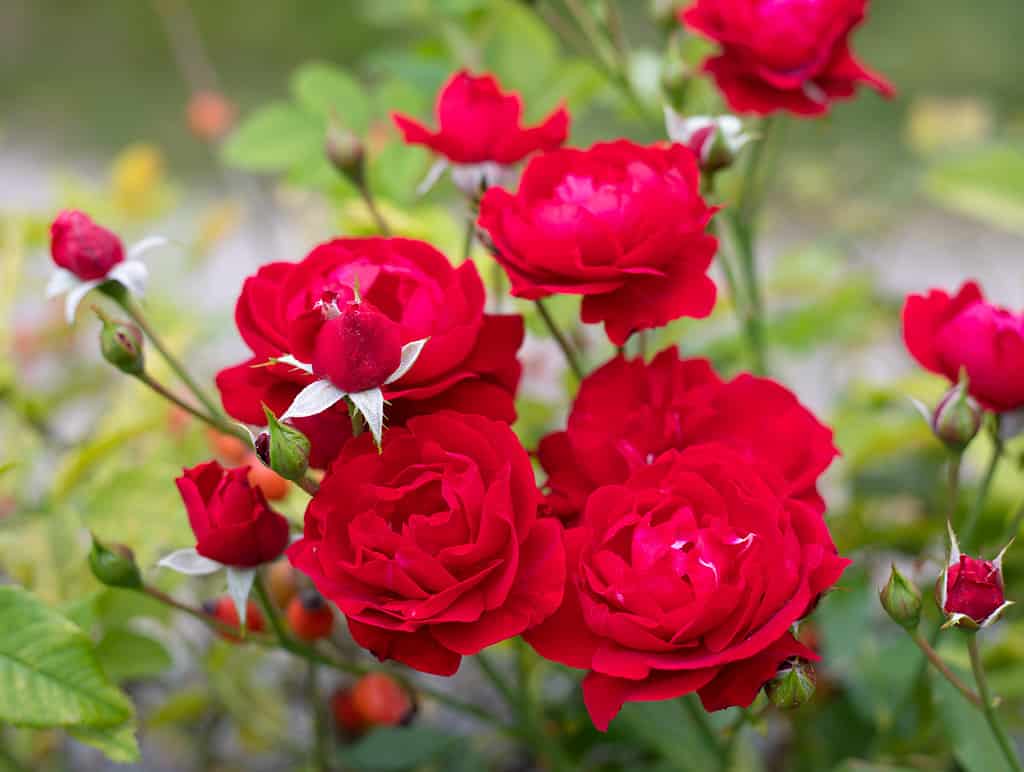
While roses most famously mean love, these flowers can also mean happiness and even suffering!
©Maria Rzeszotarska/iStock via Getty Images
Rose stems often feature thorns and bear glossy, green leaves with serrated margins. The flowers of the rose plant come in a variety of sizes and shapes, exhibiting subtle shades like pastel pink, peach, and cream to more vibrant tones such as yellow, orange, and blood red. While many roses delight with their gorgeous fragrance, others yield berry-resembling fruits known as hips.
Universally acknowledged as amongst the most stunning and expressive flowers, roses have historically been a symbol of happiness and love, among other meanings. The rose enjoys a privileged position in many societies as a representation of happiness. This association has its roots in ancient times, with civilizations like the Greeks and Romans using roses as symbols connected to Aphrodite and Venus, the goddesses representing love, beauty, and joy.
Moving forward in time, Christian narratives established a link between the rose and the Virgin Mary, who is frequently depicted with roses as signs of heavenly love, happiness, and even suffering.
10. Tulip (Tulipa)
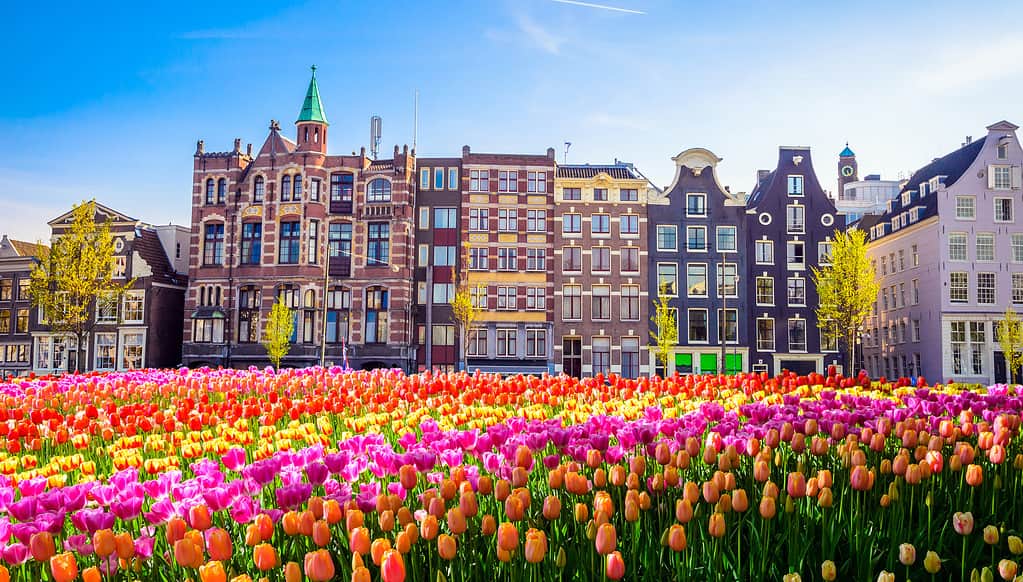
For many years, tulips have carried the meaning of happiness and joy.
©Olena_Z/iStock via Getty Images
Tulips stand upright with elongated, wide leaves featuring parallel veins, culminating in a cup-formed, single or double blossom atop the stem. These flowers come in a variety of sizes, colors, and blooming periods. Though red remains a traditional color for tulips, they also flourish in shades of pink, white, yellow, purple, orange, and many other intermediate shades.
For ages, tulips have stood as cherished icons of happiness and delight. Their colorful shades and uplifting demeanor have the power to ignite sensations of joy and contentment. In contemporary times, tulips represent symbols of positivity. Frequently chosen as presents to convey affection, thankfulness, and well wishes, they grace numerous occasions, including weddings, adding a note of celebration and happiness. This is especially the case with yellow tulips.
11. Peony (Paeonia)
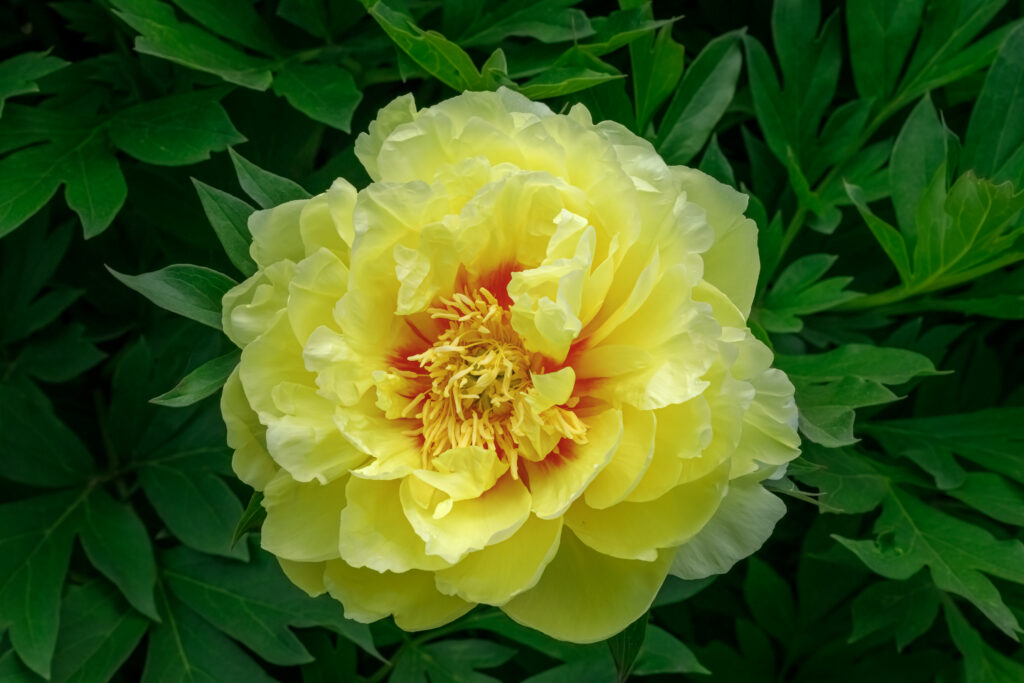
Another gorgeous flower that means happiness is the peony.
©Nnattalli/Shutterstock.com
Peonies, celebrated for their opulent and extravagant blooms, stand out as one of the most popular flowers in the world. These perennial plants boast large, showy blossoms that come in a huge array of colors, including white, pink, and red. On top of its beauty, peonies also boast a sweet fragrance that is pleasing to all. These flowers consist of single, semi-double, or double layers of petals, giving them a full look.
Comprising around 30 known species, peonies are popular garden plants that only bloom for a short period, around a week. However fleeting their bloom time, these flowers grace us with their magnificent presence over the warmer months.
Peonies have long been symbols of prosperity, good fortune, and honor in many cultures. In Chinese tradition, for example, the peony represents wealth and nobility, having been grown and enjoyed by Chinese emperors. Peonies also embody happiness. After all, its fragrant blooms are bound to make anyone joyful and content, making these flowers a perfect choice for celebrations – weddings in particular!
Summary of Gorgeous Flowers That Mean Happiness
| Number | Flower | Botanical Name |
|---|---|---|
| 1 | Sweet Pea Flower | Lathyrus odoratus |
| 2 | Daffodil Flower | Narcissus |
| 3 | Stocks Flower | Matthiola |
| 4 | Lupine Flower | Lupinus |
| 5 | Wishbone Flower | Torenia fournieri |
| 6 | Dandelion | Taraxacum |
| 7 | Sunflower | Helianthus |
| 8 | Lily | Lilium |
| 9 | Rose | Rosa |
| 10 | Tulip | Tulipa |
| 11 | Peony | Paeonia |
The photo featured at the top of this post is © Nnattalli/Shutterstock.com
Thank you for reading! Have some feedback for us? Contact the AZ Animals editorial team.







